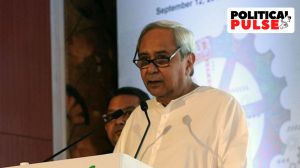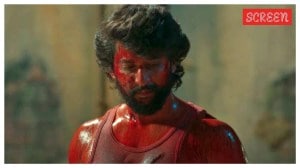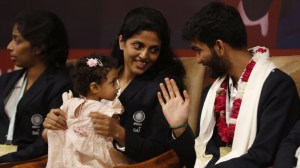How a British architect Chisolm’s notes helped reinstate Vadodara’s iconic MSU dome with jaggery, spice & everything nice
From repair and replacing delicate jaalis to polishing woodwork and reinforcing the very frame of the dome, a firm from Mumbai is undertaking detailed restoration of the 19th Century dome at MSU’s Faculty of Arts building. The work, which has now been going on for 18 months, is expected to be completed by August.
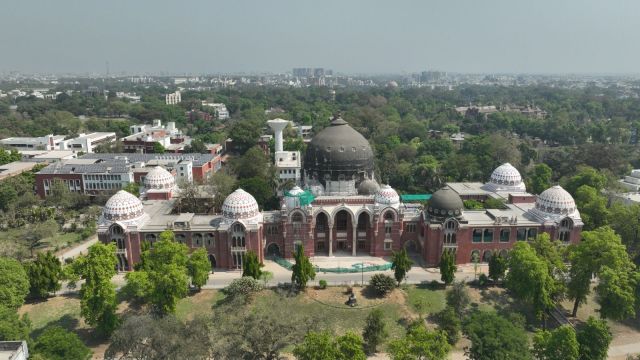 A view of the dome at the Faculty of Arts in Vadodara's Maharaja Sayajirao University during ongoing renovation. (Photo: Express photo)
A view of the dome at the Faculty of Arts in Vadodara's Maharaja Sayajirao University during ongoing renovation. (Photo: Express photo)At the 145-year-old heritage Faculty of Arts building of Vadodara’s Maharaja Sayajirao University (MSU), a group of three men stand on the campus grounds, considering how best to send some intricately carved sandstone jaalis to their peers standing on the first floor of the building. Inside, a worker is busy polishing heavy wooden door frames while another is painstakingly painting over a delicately engraved potted plant on the facade on the ground floor.
For the last 18 months, the MSU’s 19th Century arts faculty building, with its amalgam of Indian and Byzantine arches and its peculiar marriage of local Gaekwad and the Baroque architecture, has been humming with activity. Here, 100 workers have been working on a long but ambitious project: to breathe new life into the iconic double-layered masonry dome designed in 1880 by British architect Robert Fellows Chisholm.
What makes the project complex yet exceptional, according to experts involved in it, is how it uniquely blends traditional building materials such as lime plaster and sandstone with out-of-the-box ones – such as a mixture of jaggery, urad (black gram), fenugreek, and wheat – to help reinforce its foundation. The renovation work involves a vast amount of work – from painting broken bits of the edifice and restoring paintings and woodwork to mending, and replacing, even the smallest nicks in jaalis – all the while ensuring that the work remains faithful to the original.
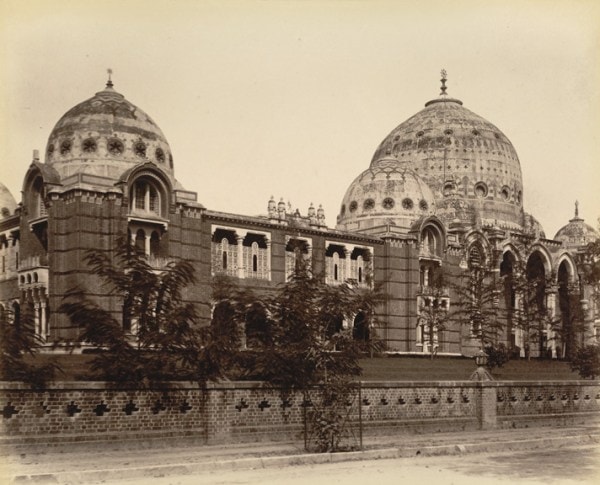 A view of the erstwhile Baroda College, now called the Maharaja Sayajirao University, in Vadodara. (Express photo)
A view of the erstwhile Baroda College, now called the Maharaja Sayajirao University, in Vadodara. (Express photo)
For this, conservationists are getting help from Chisholm himself – specifically, his notes from ‘The Transactions’, an 1883 book unveiled by the Royal Institute of British Architects, Rudresh Sharma, chief engineer and MSU’s Officer on Special Duty who is overseeing the restoration by the Mumbai-based Savani Heritage Conservation Pvt Ltd, tells The Indian Express, adding that work is now on the home stretch and is likely to be completed by August.
This comes after at least two failed attempts to reinstate the dome, the last one being in 2018, when the Archaeological Survey of India drilled “more than 100 holes”.

“The restoration was called off after that incident… It took us two years of studying the structure and examining documents– through books by Chisholm, records from the Museum of the royal family (the Gaekwads) as well as other sources — to arrive at a restoration plan,” Sharma says.
So far, the university has completed seven domes and the majority of the structural and surface work. The estimated cost of repair, university officials say, is likely to escalate from the initial Rs 5.5 crore — being borne by the state government.
Reinforcing structure, replacing delicate jaalis
One of western India’s oldest colleges for education, the MSU was founded by Maharaja Sayajirao Gaekwad III – of the Gaekwad royal family of Baroda — in 1881 as Baroda College but was eventually renamed as the Maharaja Sayajirao University of Baroda in 1949.
From the top, the Faculty of Arts building resembles the English alphabet ‘E’, with the ‘Arts Faculty Dome’ forming the central arm of the alphabet. A double-layered exposed-brick structure with an Ashoka Chakra on the top, the lotus-shaped central dome – considered an engineering marvel — houses the Premanand Sahitya Sabha under, now renamed as the Central Hall, hosts convocations and exhibitions. It is flanked by six smaller domes and two additional cupolas at the front façade.
Until October 2018, when it was bumped to number three, the Faculty of Arts building wore the crown of Asia’s second largest dome after the Gol Gumbaz in Bijapur, Karnataka.
Like everything else, this project too started with research — a thorough examination of photographs, documents and Chisholm’s notes to help replicate the dome down to the last detail. According to Hitesh D. Raviya, MSU’s Officer on Special Duty (Public Relations and Communication), Chisholm considered his deep respect for India’s artistic heritage as the most enduring aspect of his work.
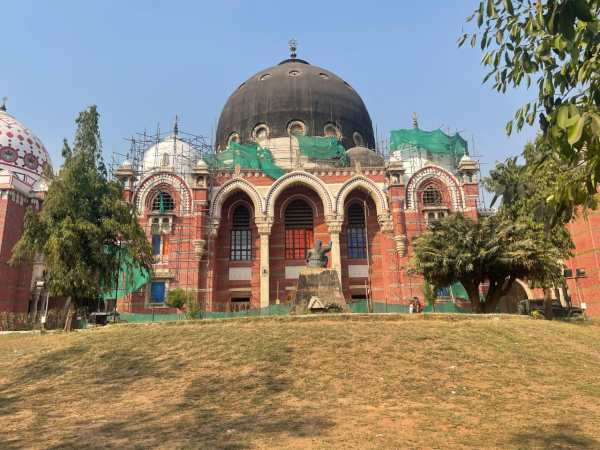 Ongoing renovation work at the Faculty of Arts in Vadodara’s Maharaja Sayajirao University during ongoing renovation. (Express photo)
Ongoing renovation work at the Faculty of Arts in Vadodara’s Maharaja Sayajirao University during ongoing renovation. (Express photo)
“He recognised that the richness of native art resided not only in its forms but in the skilled hands of Indian artisans,” Raviya tells The Indian Express. “Chisholm was acutely aware of the architectural dilemmas faced by British architects working in India. They could either replicate ancient Indian styles wholesale, risking inauthenticity, or adapt elements of those styles with sensitivity to new needs. Chisholm advocated for the latter, championing an approach that preserved the ‘expression’ of Indian architecture, and not just its decorative forms.”
Conservationists working on restoring the dome too are staying true to this belief, using natural pigments from Rajasthan and Belgian wood polish to bring back its original colour.
The dome is lime masonry work with exposed brick and wood. The first step was repointing — the process of renewing the external mortar joints by removing the old and disintegrated mortar, , says Sharma.
“There was no cement plaster in the original design, so we also removed the cement plaster used during faulty repair work done earlier,” he says.
Next was to use the same materials as the original to reinforce the structure. For this, lime plaster was made with slaked lime – made when quicklime reacts with water — as the primary binder. Next, natural ingredients such as jaggery, fenugreek, and wheat are boiled for several hours and allowed to ferment before being added to the plaster to give it strengthening and waterproofing qualities.
The restoration process also involved replacing bricks that were crumbling and damaged due to water seepage. “The structure is made of first-class bricks, which can sustain without plaster, and are different from regular bricks used in modern-day construction,” Sharma says.
The central dome, which fuses the Indian and Byzantine arches in polychromed stone, also has stone lattice balconies and designs resembling the crescent of Lord Shiva as well as Buddhist symbols. The original dome marries elements of Rajasthani architecture – such as ‘chhatris’– with Adilshahi, local Gaekwad and British architecture.
To help remain faithful to Chisholm’s work, experts had to bring in elements from the original design – from replicating delicate yellow sandstone jaalis to ceramic tiles. “Even the wood work had deteriorated in many parts and we have replaced it by replicating the original design,” says Sharma. “Sandstone had to be brought from Dhrangadhra (in Gujarat’s Surendranagar district) to also replicate the intricate carvings of the original jaali designs in many damaged places. We have also replicated the pattern in the ceramic tiles and replaced those that were either damaged due to age or mischievously removed. The damaged Belgian glass panels have been replaced with exact designs as the original.”
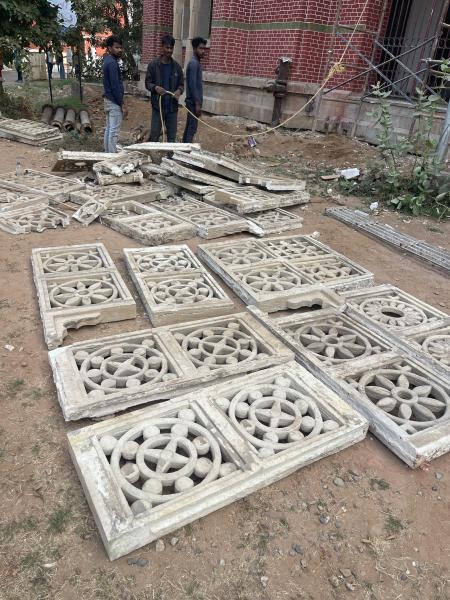 Ongoing renovation work at the Faculty of Arts in Vadodara’s Maharaja Sayajirao University during ongoing renovation. (Express photo)
Ongoing renovation work at the Faculty of Arts in Vadodara’s Maharaja Sayajirao University during ongoing renovation. (Express photo)
In its glory days, the dome also flaunted intricate fresco artwork in green, yellow ochre and red colours, although, according to most historians and conservationists who have researched the dome, there are no documented details of such artwork. Instead, they say the dome has repetitive patterns of popular motifs of the time, such as lotuses and playing cards.
Sharma, however, insists that paintings of Hindu gods Shiva and Ganesha were found “and are now being restored”. However, there is one major challenge: all old photographs are black and white, making it difficult to determine the pigments used in them.
“Despite multiple attempts, we were unable to find coloured photographs to see the exact colours of the frescos or exterior design but we have been able to estimate the tinge and shades through available information,” he says.
According to Raviya, Chisholm believed that Indian architectural styles contained a spirit and integrity that, when thoughtfully adapted, could speak powerfully to modern India.
“His (Chisholm’s) work reminds us that architecture, at its best, is not merely about constructing walls and roofs—it is about articulating cultural values, respecting local traditions, and creating spaces that reflect the spirit of their time and place,” Raviya says.
Must Read
Buzzing Now
May 05: Latest News
- 01
- 02
- 03
- 04
- 05



